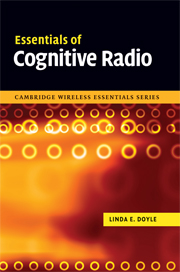Book contents
- Frontmatter
- Contents
- Acknowledgments
- List of abbreviations
- 1 A cognitive radio world
- 2 The essentials – an overview
- 3 Taking action
- 4 Observing the outside world
- 5 Making decisions
- 6 Security in cognitive radio
- 7 Cognitive radio platforms
- 8 Cognitive radio regulation and standardisation
- 9 Conclusions
- Appendix A Developments in the TV white spaces in the USA
- Index
2 - The essentials – an overview
Published online by Cambridge University Press: 10 August 2009
- Frontmatter
- Contents
- Acknowledgments
- List of abbreviations
- 1 A cognitive radio world
- 2 The essentials – an overview
- 3 Taking action
- 4 Observing the outside world
- 5 Making decisions
- 6 Security in cognitive radio
- 7 Cognitive radio platforms
- 8 Cognitive radio regulation and standardisation
- 9 Conclusions
- Appendix A Developments in the TV white spaces in the USA
- Index
Summary
Introduction
The first chapter of this book focused on the application areas that will drive cognitive radio technology. This chapter acts as a bridge to the remainder of the book. It seeks to provide the reader with a broad sense of all that is involved in cognitive radio technology. In order to do this we go to the heart of the cognitive radio but not at first using technology as an example. Instead we step back and take a look at how decisions are made in a more abstract manner before returning to the radio world. The final part of the chapter provides a roadmap for the rest of the book.
Setting the scene for understanding cognitive radio
The first question to think about is: how do we make decisions? How do we reason and come to conclusions? We begin this discussion by looking at a simple example.
The lone radio
Scenario 1: I am about to go out and must decide whether I should take an umbrella with me or not. The umbrella is heavy and cumbersome and, while I don't want to get wet, I don't want to take the umbrella with me if it is not necessary.
In this example two actions are possible, namely take umbrella or don't take umbrella. I need to determine how likely it is to rain in order to decide whether to take the umbrella or not.
- Type
- Chapter
- Information
- Essentials of Cognitive Radio , pp. 33 - 46Publisher: Cambridge University PressPrint publication year: 2009



